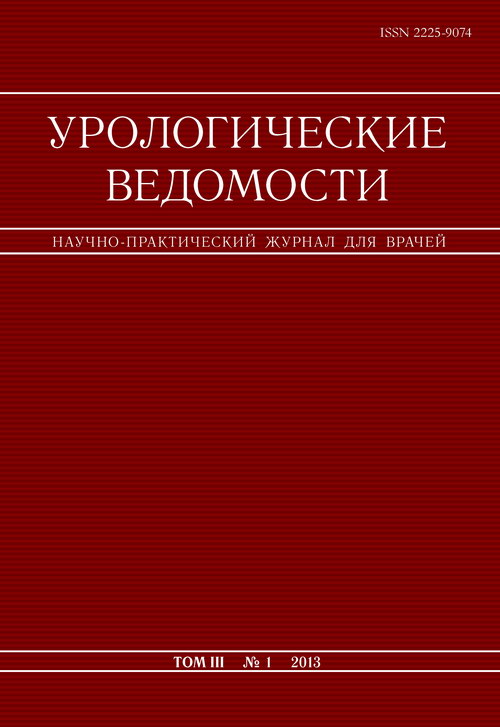Новый цистометрический показатель — индексчувствительности мочевого пузыря
- Авторы: Аль-Шукри С.Х.1, Кузьмин И.В.1
-
Учреждения:
- Санкт-Петербургский государственный медицинский университет им. акад. И. П. Павлова
- Выпуск: Том 3, № 1 (2013)
- Страницы: 5-7
- Раздел: Статьи
- Статья получена: 30.03.2016
- Статья опубликована: 15.03.2013
- URL: https://journals.eco-vector.com/uroved/article/view/2499
- DOI: https://doi.org/10.17816/uroved315-7
- ID: 2499
Цитировать
Полный текст
Аннотация
Анализ результатов уродинамических исследований 341 больного с гиперактивностью мочевого пузыря показал возможность использования нового уродинамического показателя — индекса чувствительности мочевого пузыря (ИЧ). ИЧ рассчитывается как отношение максимальной емкости мочевого пузыря к объему наполнения мочевого пузыря при первом позыве на мочеиспускание. Значения ИЧ зависят от пола пациента, наличия у него непроизвольных сокращений детрузора и частоты императивных позывов (R2 = 0,03; F = 5,80; p < 0,004). Величина ИЧ отражает скорость нарастания интенсивности позыва на мочеиспускание и может быть дополнительным уродинамическим критерием тяжести гиперактивности мочевого пузыря
Полный текст
Об авторах
Сальман Хасунович Аль-Шукри
Санкт-Петербургский государственный медицинский университет им. акад. И. П. Павлова
Email: al-shukri@mail.ru
д. м. н., профессор, заведующий кафедрой урологии
Игорь Валентинович Кузьмин
Санкт-Петербургский государственный медицинский университет им. акад. И. П. Павлова
Email: kuzminigor@mail.ru
д. м. н., профессор кафедры урологии
Список литературы
- Abrams P., Cardozo L., Fall M. et al. The standardization of terminology of lower urinary tract function: report from the stadardisation sub-committee of the International Continence Society // Neurourol. Urodynam. — 2002. — Vol. 21, N 2. — P. 167–178.
- Abrams P., Chapple C. R., Jünemann K., Sharpe S. Urinary urgency: a review of its assessment as the key symptom of the overactive bladder syndrome // World J. Urol. — 2012. — Vol. 30, N 3. — P. 385–392.
- Schäfer W., Abrams P., Liao L. et al. Good urodynamic practices: uroflowmetry, filling cystometry, and pressure-flow studies // Neurourol. Urodyn. — 2002. — Vol. 21, N 3. — P. 261–274.
- Jarvis G. J. The management of urinary incontinence due to primary vesical sensory urgency by bladder drill // Br. J. Urol. — 1982. — Vol. 54. — P. 374–376.
- Hjalmas K. Urodynamics in normal infants and children // Scand. J. Urol. Nephrol. (Suppl). — 1988. — Vol. 114. — P. 20–27.
- Gilmour R. F., Churchill B. M., Steckler R. E. at al. A new technique for dynamic analysis of bladder compliance // J. Urol. — 1993. — Vol. 150, N 4. — P. 1200–1203.
- Cantor T. J., Bates C. B. A comparative study of symptoms and objective urodinamic findings in 214 incontinent women // Br. J. Obstet. Gynecol. — 1980. — Vol. 87, N 10. — P. 889–892.
- Clarke B. The role of urodynamic assessment in the diagnosis of lower urinary tract disorders // Int. Urogynecol. J. Pelvic. Floor Dysfunct. — 1997. — Vol. 8, N 4. — P. 196–199.
- De la Rosette J., Witjes W., Schafer W. et al. Relationships between lower urinary tract symptoms and bladder outlet obstruction: results from the ICS-BPH study // Neurourol. Urodyn. — 1998. — Vol. 17, N 2. — P. 99–108.
- Wagg A., Bayliss M., Ingham N. J. et al. Urodynamic variables cannot be used to classify the severity of detrusor instability // Br. J. Urol. — 1998. — Vol. 82, N 4. — P. 499–502.
- Wiskind A. K., Miller K. F., Wall L. L. One hundred unstable bladders // Obstetrics & Gynecology. — 1994. — Vol. 83, N 1. — P. 108–112.
- Bergman A., Bader K. Reliability in the patient’s history in the diagnosis of urinary incontinence // Int. J. Gynaecol. Obstet. — 1990. — Vol. 32, N 3. — P. 255–259.
- Кузьмин И. В. Патогенез, клиническое течение и лечение гиперактивности мочевого пузыря. Автореферат дисс… д. м. н., Санкт-Петербург, 2007. — 39 с.
Дополнительные файлы









